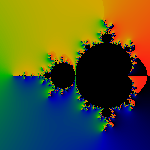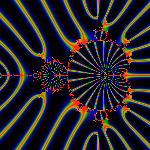Douady-Hubbard Potential
The
generalization of the integer iteration count
gives us a handy tool for computing other quantities, including
Douady-Hubbard rays.
This is because the renormalized count can be used to provide a simple
expression for the Douady-Hubbard potential. We give the the expression,
and then prove that the potential is indeed harmonic, immediately below.
The iterated quadratic is
zn+1 = zn2+c
The renormalized iteration count is
m(R) = n+1 - log(log |zn|) / log 2
where we have picked an escape radius R, and defined n to be the
smallest n such that R < |zn| . Then, as shown on the
Escape Page, m(R) is
'almost' independent of R and n, in the sense that m approaches a
well-defined limit as R->oo, and, in fact, converges very rapidly.
It is also 'almost' continuous and smooth, in the sense that
there are only a measure-zero of discontinuities for finite R, and that
all discontinuities are bounded, and get vanishingly small in the limit
of R->oo. That is, in the limit, m becomes continuous and
smooth, and, as a practical, computational matter, is plenty smooth
enough for small R (100 to 10000). Below, when we write m, we sometimes
mean the limit m(R->oo) and sometimes m(R) for finite R, and most
of the statements apply to either.
The Douady-Hubbard potential is just
f = e-m log2 = 2-m
Let us now show that f is harmonic, both in the limit R->oo and
for finite R, and that it has the right asymptotic behavior.
The limitations of html make this presentation hard. Please bear with
us as we define some basic notation.
Lets define the derivative w.r.t a complex variable c=x+iy in the usual
fashion:
D = d/dc = (d/dx - id/dy)/2
and
D = d/dc = (d/dx + id/dy)/2
where we use an underline to denote complex conjugate (because 'overline',
the usual way of showing this, is not available in html). The harmonic
or Laplacian is then just
4 DD = d2/dx2 + d2/dy2
Lets review some trivial factoids to make sure we're on the same
page. Since zn(c,c) = zn(c) is not a
function of c, we have Dz = Dz = 0 . The modulus
is just |z| = sqrt(zz), and the derivative of the modulus is
D|z| = z Dz / (2|z|) . We can now combine these to compute
the Laplacian of the the renormalized iteration count:
4 DD m = Dzn Dzn /
(log 2 |zn|2 log2 |zn|)
Note that this depends implicitly on the escape radius R, since by definition,
R < |zn|. Thus, it would seem that the harmonic can be made
arbitrarily small, provided the numerator was bounded. Unfortunately, it
is not; not only is it unbounded, but it diverges 'worse than
exponentially' as one approaches the boundary of the M-set.
The Laplacian of the potential is
4 DD f = 4f (log22 Dm Dm - log2 DDm)
But
Dm = D|zn| / (log2 |zn| log |zn|)
Substituting from the above, we can easily see
DD f = 0
both for finite R and R->oo. For finite R, f has 'small'
discontinuities, which vanish in the limit; thus the harmonic is
non-zero on the discontinuities, but these vanish in the limit, and
f is harmonic everywhere outside the M-set.
To complete this analysis of this
function, we check the asymptotic behavior.
For finite R, we can write f(R) = 2-(n+1) log |zn| .
Thus, for c approaching the boundary of the M-set, n gets infinitely large,
whereas |zn| < R2
and so f=0 on the boundary.
At the other end, for large c, we can approximate
zn+1 ~zn2 for any n, and so
m ~ 2 - log(log |c|) / log 2
and
f ~ log |c| / 4
for large c.
Now that we have f, we should play a few games.
We could draw a picture of f, but that in fact is 'boring'.
f gets exponentially flat as it approaches the boundary of
the M-set, and thus, it looks like a very blurry low-res picture
of the M-set. Boring.
The gradient is more interesting. The gradient 2Df always
points 'uphill':
2Df = f zn Dzn /
|zn|2 log |zn|
The picture below shows the modulus of the gradient.
 Of course, it resembles a coronal discharge. If one were to cut out
a metal plate in the shape of an M-set, apply a high voltage to it,
it is exactly this that you would see, because it is the areas of high
electric field (gradient) where the coronal ionization will occur.
Maybe make a chic lightning rod for the barn.
Of course, it resembles a coronal discharge. If one were to cut out
a metal plate in the shape of an M-set, apply a high voltage to it,
it is exactly this that you would see, because it is the areas of high
electric field (gradient) where the coronal ionization will occur.
Maybe make a chic lightning rod for the barn.
The next picture encodes the angle of the landing rays on the M-set.
 It is nothing more than the phase-angle of the gradient.
The color coding is such that black=0, blue=small angle, green=pi,
red=2pi. In other words, green points west, and red/black points
east, just as it was in the Soviet era.
It is nothing more than the phase-angle of the gradient.
The color coding is such that black=0, blue=small angle, green=pi,
red=2pi. In other words, green points west, and red/black points
east, just as it was in the Soviet era.
This last image shows some landing rays.
 A 'landing ray' is just the integral flow along the gradient lines of
the potential; i.e. the path a rock rolling down the hill to the M-set
would take. We've picked 31 evenly-spaced angles at infinity; the red
lines indicate the flow along these paths. The color gradations help
show the behavior of some neighboring rays: i.e. the blue rays are
nearby neighbors of the red rays. The spreading as they 'land' on the
M-set just helps show that rays become radically divergent. The
Mandelbrot interior is an artifact of the algorithm, and are not a part
of the Douady-Hubbard isomorphism.
See the Winding Page for more details
on the derivation, and more pictures.
A 'landing ray' is just the integral flow along the gradient lines of
the potential; i.e. the path a rock rolling down the hill to the M-set
would take. We've picked 31 evenly-spaced angles at infinity; the red
lines indicate the flow along these paths. The color gradations help
show the behavior of some neighboring rays: i.e. the blue rays are
nearby neighbors of the red rays. The spreading as they 'land' on the
M-set just helps show that rays become radically divergent. The
Mandelbrot interior is an artifact of the algorithm, and are not a part
of the Douady-Hubbard isomorphism.
See the Winding Page for more details
on the derivation, and more pictures.
References
- John Milnor, Periodic Orbits, External Rays and the Mandelbrot
Set: An Expository Account, (postscript,
mirror of StonyBrook preprint).
Created by Linas Vepstas December 2000
linas@linas.org
Return to Linas' Art Gallery
Copyright (c) 2000 Linas Vepstas.

Douady Hubbard Potential
by Linas Vepstas is licensed under a
Creative Commons
Attribution-ShareAlike 4.0 International License.
 Of course, it resembles a coronal discharge. If one were to cut out
a metal plate in the shape of an M-set, apply a high voltage to it,
it is exactly this that you would see, because it is the areas of high
electric field (gradient) where the coronal ionization will occur.
Maybe make a chic lightning rod for the barn.
Of course, it resembles a coronal discharge. If one were to cut out
a metal plate in the shape of an M-set, apply a high voltage to it,
it is exactly this that you would see, because it is the areas of high
electric field (gradient) where the coronal ionization will occur.
Maybe make a chic lightning rod for the barn.


